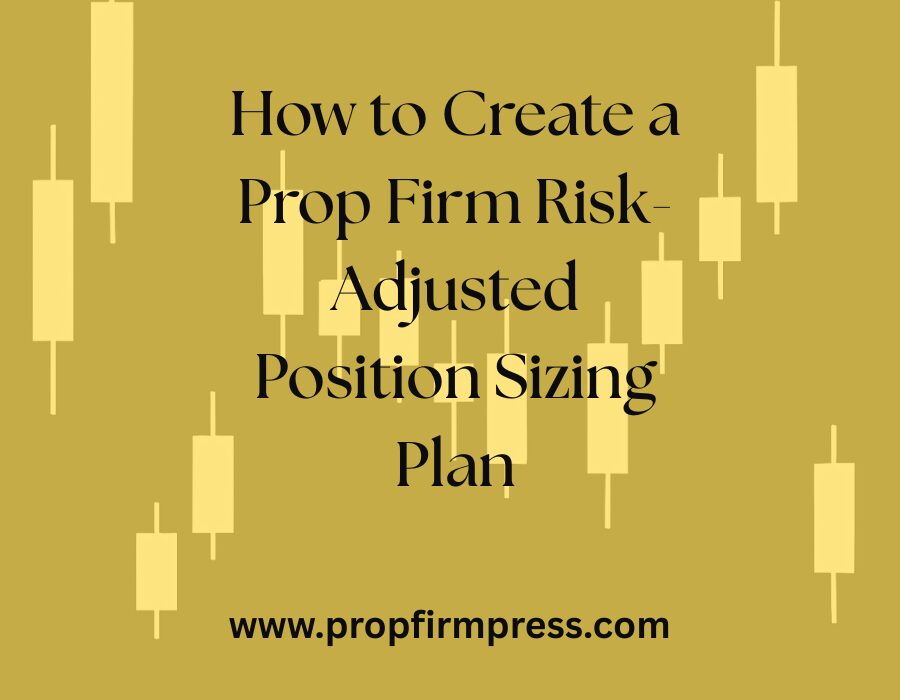How to Create a Prop Firm Risk-Adjusted Position Sizing Plan
Position sizing is a crucial element for any trader working within a prop firm environment. Managing risk effectively not only preserves capital but also maximizes growth opportunities. This article delves into the process of crafting a risk-adjusted position sizing plan that aligns with prop firm requirements and personal trading goals.
Understanding Risk-Adjusted Position Sizing
Risk-adjusted position sizing evaluates trade size based on both the potential risk and the expected reward. Unlike fixed position sizing, this method adapts size based on market conditions, volatility, and individual trade setups. For prop firm traders, adhering to risk-adjusted sizing protects the firm’s capital and ensures compliance with risk limits.
Risk management in trading involves controlling the amount of capital at risk per trade, often expressed as a percentage of the total trading account. Prop firms typically set a maximum risk per trade, such as 1% or less of the trading account, to safeguard funds from excessive drawdowns.
Step 1: Define Your Maximum Risk Per Trade
Start by determining the maximum acceptable loss for each trade. This figure is often a small percentage of the total account balance. For example, a 1% risk per trade on a $100,000 prop firm account means risking $1,000 on any single position.
Accurately setting this limit ensures losses remain manageable, preventing any one trade from significantly damaging the trader’s overall capital. This keeps you aligned with the capital preservation guidelines common in prop firm contracts.
Step 2: Calculate the Trade Risk Based on Stop Loss
Once the maximum risk per trade is established, calculate how many units or shares to trade based on your stop loss distance. The stop loss defines the maximum adverse movement you’re willing to tolerate before exiting the trade.
The formula is straightforward: Position Size = (Maximum Risk per Trade) / (Risk per Unit), where Risk per Unit is the difference between your entry price and stop loss price. For example, if your maximum risk is $1,000 and the stop loss is $2 away from your entry, position size would be 500 units.
This ensures every trade has consistent risk exposure regardless of instrument price or volatility, vital for meeting prop firm risk controls.
Step 3: Adjust Position Sizes for Volatility
Markets fluctuate in volatility, requiring an adaptive approach to position sizing. Higher volatility calls for smaller positions to avoid large drawdowns, while lower volatility allows for bigger trade sizes.
Use tools like Average True Range (ATR) to gauge the volatility of an asset. For example, if the ATR increases, indicating higher volatility, reduce your position size accordingly to maintain consistent dollar risk.
Volatility-adjusted sizing helps protect your account during turbulent market conditions and leverages calmer periods for more significant gains.
Step 4: Incorporate Prop Firm Risk Constraints
Each prop firm enforces specific risk parameters such as daily loss limits, maximum drawdowns, and maximum position sizes. Before determining your position sizes, thoroughly understand these constraints.
For example, if a firm limits daily loss to 2%, and you risk 1% per trade, you should cap yourself at two losing trades per day. This information helps in planning both position size and the number of trades to place.
Adhering strictly to these rules avoids automatic termination and builds trust between you and the firm.
Step 5: Factor in Correlation Between Trades
Managing portfolio risk also means avoiding excessive exposure to correlated instruments. Positions moving in the same direction simultaneously increase risk beyond individual trade risk levels.
When sizing positions, factor in the correlation coefficient between assets. If trading multiple correlated positions, reduce individual trade sizes to keep aggregate risk within limits defined by your prop firm or personal risk tolerance.
This practice prevents large drawdowns caused by multiple trades moving against you simultaneously.
Step 6: Use Position Sizing Calculators and Trading Journals
Leverage online position sizing calculators to streamline the process and minimize errors. Many prop firm traders benefit from calculators that integrate stop loss distance, account size, and risk percentage to instantly reveal optimal position sizes.
Additionally, keeping a detailed trading journal allows you to record each trade’s position size, entry, stop loss, and outcome. Over time, analyzing journal data can highlight strengths and weaknesses in your sizing strategy and improve future adjustments.
Step 7: Continually Monitor and Adjust Your Plan
Markets change, and so should your risk-adjusted position sizing plan. Periodically review your trading performance against your risk parameters. If you experience consistently smaller or larger drawdowns than expected, recalibrate your risk percentage or stop loss strategies accordingly.
Prop firms appreciate disciplined traders who demonstrate adaptability and risk control over time. Regular refinement also ensures that your position sizing remains aligned with evolving market conditions and your growing experience.
Additional Tips for Effective Risk-Adjusted Position Sizing
Maintain emotional discipline to prevent impulsive trades that ignore position sizing rules. Automation tools in trading platforms can enforce position limits and stop losses to reduce human error.
Always test your plan in a simulated environment before applying it live under a prop firm. This approach avoids costly mistakes while building confidence in your sizing method.
Position sizing is not just about risk control but also about optimizing growth. Finding the sweet spot between risk and reward through a calculated plan increases long-term profitability and consistency.
Why Risk-Adjusted Position Sizing is Vital for Prop Trading Success
Prop trading firms provide access to substantial leverage and capital that demands strict adherence to risk management principles. A robust risk-adjusted position sizing plan is vital to protect that capital and extend your trading career.
Without proper sizing, even a few losing trades can wipe out your account or breach firm rules leading to penalties or contract termination. Conversely, calculated position sizing balances safety with the opportunity to compound gains steadily.
Ultimately, the discipline learned through creating and following a risk-adjusted position sizing plan fosters better decision-making and consistency—key traits for enduring success in prop trading environments.
